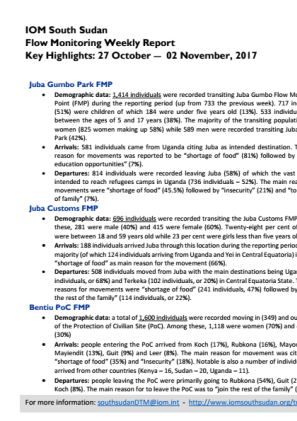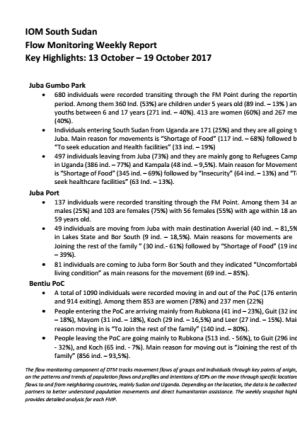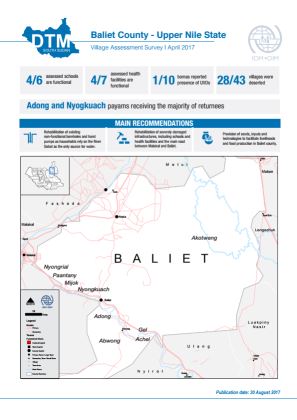-
Countries
-
Data and Analysis
-
Special Focus
-
Crisis Responses
South Sudan
South Sudan
Desplazados internos rastreados
Movimientos de desplazamiento
1,121,000
IDMC 2023
Ronda de recopilación de datos
Sobre South Sudan
Conflict and instability in South Sudan have resulted in large-scale internal and cross-border displacement since the December 2013 crisis of over 4 million individuals. In September 2018, the Revitalized Agreement for the Resolution of the Conflict in South Sudan (R-ARCSS) was signed between the major warring parties. Whilst overall there have been improvements in security since and returns are ongoing, fighting and communal clashes (frequently linked to cattle raiding) continue to trigger new displacements and the situation remains volatile.
DTM South Sudan’s toolbox is designed to meet critical information gaps during all phases of response, from preparedness, to intervention and transition/recovery. DTM South Sudan provides country-wide figures on the numbers, locations and priority needs of IDPs and returnees updated on a quarterly and ad-hoc basis. The programme undertakes biometric registration in selected parts of the country to support partners with reaching intended beneficiaries during distributions. Flow monitoring data is collected on a daily basis at displacement sites, key transit hubs and border crossing points to identify mobility dynamics of migrants including IPDs and returnees. Through ad hoc surveys, headcounts, infrastructure/service mapping exercises and other assessments, DTM provides additional information to support partners in planning their response.
Contacto
IOM South Sudan DTM Juba
ISSDTM@iom.int
Current Donors
- Switzerland
- Japan
- DFID
- ECHO
- OCHA
- OFDA
- Canada (DFATD)
- WFP
- UN Peacebuilding Fund
- World Bank
Para obtener resultados de búsqueda más avanzados, vaya a la Página de búsqueda avanzada de informes
South Sudan — Flow Monitoring Weekly Report (27 October — 2 November 2017)
IOM conducted flow monitoring at various cross border points, transit areas, PoCs, and IDP Collective sites across South Sudan.
South Sudan — Flow Monitoring Weekly Report (20—26 October 2017)
IOM conducted flow monitoring at various cross border points, transit areas, PoCs, and IDP Collective sites across South Sudan.
South Sudan — Flow Monitoring Weekly Report (13—19 October 2017)
IOM conducted flow monitoring at various cross border points, transit areas, PoCs, and IDP Collective sites across South Sudan. Flow monitoring captures the movement dynamics of the displaced population in the country.
South Sudan — Wonduruba, Lainya County Rapid Needs Assessment Report (18—25 August 2017)
DTM and NFI teams collected updated information on the number and needs of IDPs within South Sudan in the areas of Lainya and Wonduruba. A total of 2,397 displaced households were recorded in Wonduruba, while 2,389 or 4,659 households were recorded as displaced, depending on the source.
South Sudan — Flow Monitoring Weekly Report (15—21 September 2017)
A significant decrease (23%) was recorded in people transiting through Juba Gumbo Park compared to the previous week (1083 individuals compared to 1401).
South Sudan — Flow Monitoring Weekly Report (25—31 August 2017)
In this Flow Monitoring Weekly Report, it was found that there was a significant decrease (by 63%) in exits from Malakal PoC in comparison to the last week. 65 individuals exited during this reporting period in comparison to 178 individuals last week.
South Sudan — Baliet County Village Assessment Survey (25 April — 2 May 2017)
This Village Assessment Survey report for Baliet County, Upper Nile State was conducted from 25 April to 2 May 2017 covering seven payams.
South Sudan — Rubkona Village Assessment Survey (30 March — 13 April 2017)
This Rubkona Village Assessment Survey covers a period from 30 March to 13 April 2017. Notably, it was found that 55% of education facilities are functional, 44% of health facilities are funcational, and 44% of boreholes are functional.
South Sudan — Cross Border Flow Monitoring (July 2017)
This Cross Border Flow Monitoring Report highlights the movement trends of South Sudanese crossing from South Sudan into neighbouring countries throughout July 2017.
South Sudan — Flow Monitoring Dataset / Dashboard (14—20 July 2017)
The Flow Monitoring Dataset/Dashboard provides the raw datasets and dashboards for more in-depth analysis at each flow monitoring point. The first tab contains guidelines on how to use the dataset/dashboard, and the second tab contains the flow monitoring data sheet.
South Sudan — Cross Border Flow Monitoring (June 2017)
This Abyei Cross Border Flow Monitoring Report highlights the movement trends of South Sudanese crossing from South Sudan or parts of Abyei into Sudan and vice versa over the period of January to June 2017.
South Sudan — Flow Monitoring Dataset / Dashboard (11—17 August 2017)
The Flow Monitoring Dataset/Dashboard provides the raw datasets and dashboards for more in-depth analysis at each flow monitoring point. The first tab contains guidelines on how to use the dataset/dashboard, and the second tab contains the flow monitoring data sheet.
South Sudan — Flow Monitoring Weekly Report (11–17 August 2017)
Of overall transit movements over the past three weeks, Juba Gumbo Park saw an increasing proportion of households coming from Uganda. Of those coming from Uganda, the majority (83%) are coming from refugee camps.
South Sudan — Youth Intentions Survey – Bentiu PoC, Unity (June 2017)
The Youth Intentions Baseline Survey aims to understand the perceptions and attitudes of the youth residing in Bentiu PoC in regards to their intentions to stay or leave the PoC and the types of trainings or support required to leave the PoC.
South Sudan — Biometric registration update: Malakal PoC Site, Malakal County (August 2017)
The International Organization for Migration (IOM) conducted a biometric verification exercise in the Malakal Protection of Civilians (PoC) site from 1 – 11 August 2017, covering four sectors and 48 blocks of the PoC site. A total of 24,402 individuals, or 9,184 households, were verified.
South Sudan — Kajo Keji, Central Equatoria Rapid Assessment Report (29 June –12 July 2017)
Increasing instability and conflict throughout parts of Central Equatoria, particularly around Kajo Keji, Lainya and Yei, led to the displacement of thousands of civilians around the end of 2016 and into early 2017 towards areas by the South Sudanese and Uganda border.
South Sudan — Flow Monitoring Dataset / Dashboard (4—10 August 2017)
The Flow Monitoring Dataset/Dashboard provides the raw datasets and dashboards for more in-depth analysis at each flow monitoring point.
South Sudan — Pading, Nyirol County Rapid Assessment Report (30 July – 01 August 2017)
The majority of IDPs intend to stay in their current place of displacement. There are no health facilities in Pading center or the three IDPs sites. Two functional boreholes in Pading center. No boreholes in the three IDPs sites.
South Sudan — Flow Monitoring Weekly Report (4–10 August 2017)
There has been a continued trend of high number of exits over the past weeks. This week recorded 1,222 individuals exiting, comparable to the previous reporting week of 1,128 individuals.
South Sudan — Quarterly Update (April – June 2017)
The South Sudan Quarterly Update provides an overview on DTM activities between April and march 2017 concerning biometric registration (126,563 IDPs registered), flow monitoring (18 flow monitoring points), population head count (10 IDP sites covered), rapid assessments (six sites covered) and th
South Sudan — Intentions and Needs Survey – Duk (8–12 June 2017)
83% of the surveyed population intend to stay in Duk. The majority are displaced from Uror County within Jonglei state. 92% of those who intend to stay do not know for how long they would like to stay. 71% have access to local shelter Materials. Cooking sets are the most needed non-food Item.
South Sudan — Site profile: Wau PoC area adjacent to UNMISS (June 2017)
Wau POC area adjacent to UNMISS was established in June 2016, following violence in and around Wau town, making it the most recently established POC in South Sudan.
South Sudan — Site profile: Bentiu PoC (1—15 July 2017)
The Bentiu protection of civilians (PoC) site was established in December 2013 with residence Site location 114,683 people seeking protection in the site. Humanitarian partners and UNMISS are working together with the community to improve the living condition in the PoC area.
South Sudan — Population count: Bentiu PoC (13–15 July 2017)
IDPs have been sheltering at the Bentiu protection of civilian (PoC) site since December 2013. There are currently 114,683 IDPs seeking protection in the site. Humanitarian partners and UNMISS are working with the communities to improve the living conditions in the site.
Pagination
Para obtener resultados de búsqueda más avanzados, vaya a la Página de búsqueda avanzada de conjuntos de datos
Pagination
- First page
- Previous page
- 1
- 2
- 3
- 4
- 5
- 6
Pagination
- First page
- Previous page
- …
- 13
- 14
- 15
- 16
- 17
- 18
- 19
- 20
- 21























